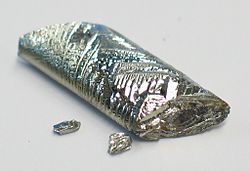Wikijunior:The Elements/Tellurium
Appearance


What does it look, feel, taste, or smell like?
[edit | edit source]
Tellurium is a silver-white metalloid. Tellurium compounds generally smell awful. If a human being is exposed to tellurium, even in very small amounts — keeping in mind, tellurium is toxic, so people shouldn't be exposed to it, even in very small amounts — their body metabolizes it so that their breath then smells so horrible that, reportedly, lab workers exposed to tellurium had to be given a leave of absence till it worked out of their system.
How was it discovered?
[edit | edit source]Where did its name come from?
[edit | edit source]The name "tellurium" comes from the Latin word tellus meaning "earth".
Where is it found?
[edit | edit source]Did You Know?
- Tellurium is chemically related to selenium and sulfur.
- Tellurium was discovered in the 18th century in a gold ore from the mines in Romania.
- Tellurium has two allotropes, crystalline and amorphous.
What are its uses?
[edit | edit source]Is it dangerous?
[edit | edit source]Yes. Tellurium is mildly toxic, so people should be very careful when handling it.
